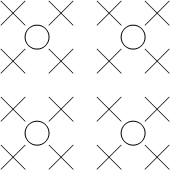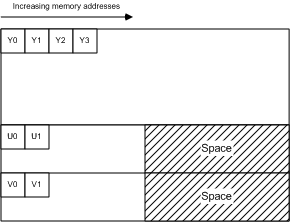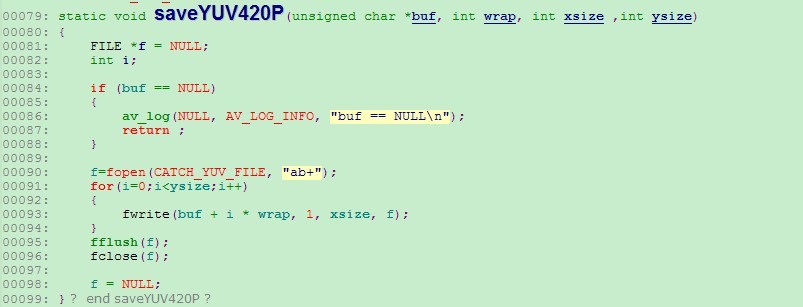FFmpeg入门(4)-An ffmpeg and SDL Tutorial 2
2014-04-23 18:10
375 查看
An ffmpeg and SDL Tutorial 2 中将1中的保存图片改为用SDL显示,在显示之前要讲本地帧改为YUV420P格式。
对照1把2 的代码进行相应修改得到:
程序2编译 运行
gcc -o tutorial02 tutorial02.1.c -lavutil -lavformat -lavcodec -lz -lm `sdl-config --cflags --libs`
gcc -g -o tutorial02 tutorial02.1.c -lavutil -lavformat -lavcodec -lswscale -lz -lm -lpthread `sdl-config --cflags --libs`

http://my.oschina.net/u/589963/blog/167766
YUV格式通常有两大类:打包(packed)格式和平面(planar)格式。前者将YUV分量存放在同一个数组中,通常是几个相邻的像素组成一个宏像素(macro-pixel);而后者使用三个数组分开存放YUV三个分量
YUV420P(planar格式)在ffmpeg中存储是在struct ***Frame的data[]数组中
data[0]-------Y分量 data[1]------U分量
data[2]-------V分量
YUV420P的内存结构:
4个Y分量对应1个UV分量

YUV420格式是指,每个像素都保留一个Y(亮度)分量,而在水平方向上,不是每行都取U和V分量,而是一行只取U分量,则其接着一行就只取V分量,以此重复(即4:2:0,
4:0:2, 4:2:0, 4:0:2 .......),所以420不是指没有V,而是指一行采样只取U,另一行采样只取V。在取U和V时,每两个Y之间取一个U或V。但从4x4矩阵列来看,每4个矩阵点Y区域中,只有一个U和V,所以它们的比值是4:1。所以对于一个像素,RGB需要8 * 3 = 24位,即占3个字节;而YUV420P,8 + 8/4 + 8/4 = 12位,即占2个字节,其中8指Y分量,8/4指U和V分量。
YUV420内存格式:
YYYYYYYY UU VV
------最常见的
YYYYYYYY UU VV
------也有,不过我开发中没遇到过


我们用ffmpeg把yuv420P 存储到文件中,然后利用一些yuv播放器就可以播放YUV原始数据,貌似VLC不能播放YUV原始数据:

data[]中存放着YUV原始数据(在struct ***Frame中的,位于frame.h中----ffmpeg)

对照1把2 的代码进行相应修改得到:
#include <libavcodec/avcodec.h>
#include <libavformat/avformat.h>
#include <libswscale/swscale.h>
#include <SDL/SDL.h>
#include <SDL/SDL_thread.h>
#include <unistd.h>
//slq
static ***FormatContext *pFormatCtx = NULL;
int main(int argc, char *argv[]) {
// ***FormatContext *pFormatCtx;
// static ***FormatContext *pFormatCtx = NULL;
***CodecContext *pCodecCtx;
***Codec *pCodec;
***Frame *pFrame;
***Frame *pFrameRGB;
***Packet packet;
SDL_Surface *screen;
SDL_Overlay *bmp;
uint8_t *buffer;
int numBytes;
int i;
av_register_all();
//slq
//reads the file header and stores information about the file format in the ***FormatContext structure pFormatCtx
if (avformat_open_input( &pFormatCtx, argv[1], NULL, NULL) < 0)
//if (avformat_open_input( &input_fmt_ctx, input_file, NULL, NULL) < 0) {
//if (av_open_input_file(&pFormatCtx, argv[1], NULL, 0, NULL) != 0)
return -1;
// Retrieve stream information
if (av_find_stream_info(pFormatCtx) < 0)
return -1;
// Dump information about file onto standard error
// dump_format(pFormatCtx, 0, argv[1], 0);
av_dump_format(pFormatCtx, 0, argv[1], 0);
// Find the first video stream
int videoStream = -1;
for (i = 0; i < pFormatCtx->nb_streams; ++i) {
if (pFormatCtx->streams[i]->codec->codec_type == ***MEDIA_TYPE_VIDEO) {
videoStream = i;
break;
}
}
// Get a pointer to the codec context for the video stream
pCodecCtx = pFormatCtx->streams[videoStream]->codec;
// Find the decoder for the video stream
pCodec = avcodec_find_decoder(pCodecCtx->codec_id);
if (pCodec == NULL) {
fprintf(stderr, "Unsupported codec@!\n");
}
// Open codec
//slq
if (avcodec_open2(pCodecCtx, pCodec, NULL) < 0)
//if (avcodec_open(pCodecCtx, pCodec) < 0)
return -1;
// Allocate video frame (native format)
pFrame = avcodec_alloc_frame();
// Allocate an ***Frame structure ( RGB )
pFrameRGB = avcodec_alloc_frame();
if (pFrameRGB == NULL)
return -1;
// we still need a place to put the raw data when we convert it.
//We use avpicture_get_size to get the size we need,
//and allocate the space manually:
// Determine required buffer size and allocate buffer
numBytes = avpicture_get_size(PIX_FMT_RGB24, pCodecCtx->width,
pCodecCtx->height);
//av_malloc is ffmpeg's malloc that is just a simple wrapper around malloc that makes sure the memory addresses are aligned and such.
buffer = (uint8_t *) av_malloc(numBytes * sizeof(uint8_t));
// Assign appropriate parts of buffer to image planes n. 图像平面;映像平面 in pFrameRGB
// Note that pFrameRGB is an ***Frame, but ***Frame is a superset
// of ***Picture
avpicture_fill((***Picture *) pFrameRGB, buffer, PIX_FMT_RGB24,
pCodecCtx->width, pCodecCtx->height);
/*
* SDL
*/
//SDL_Init() essentially tells the library what features we're going to use
if (SDL_Init(SDL_INIT_VIDEO | SDL_INIT_AUDIO | SDL_INIT_TIMER)) {
fprintf(stderr, "Could not initialize SDL - %s\n", SDL_GetError());
exit(1);
}
//This sets up a screen with the given width and height.
//The next option is the bit depth of the screen - 0 is a special value that means "same as the current display".
screen = SDL_SetVideoMode(pCodecCtx->width, pCodecCtx->height, 0, 0);
if (!screen) {
fprintf(stderr, "SDL: could not set video mode - exiting\n");
exit(1);
}
//using YV12 to display the image
bmp = SDL_CreateYUVOverlay(pCodecCtx->width, pCodecCtx->height,
SDL_YV12_OVERLAY, screen);
i = 0;
while (av_read_frame(pFormatCtx, &packet) >= 0) {
// Is this a packet from the video stream?
if (packet.stream_index == videoStream) {
int frameFinished;
/*
avcodec_decode_video(pCodecCtx, pFrame, &frameFinished, packet.data, packet.size);
*/
avcodec_decode_video2(pCodecCtx, pFrame, &frameFinished, &packet);
// Did we get a video frame?
if (frameFinished) {
#ifdef S***EFILE
/*保存到文件*/
/*
*此函数已经不用
img_convert((***Picture *)pFrameRGB, PIX_FMT_RGB24, (***Picture*)pFrame, pCodecCtx->pix_fmt, pCodecCtx->width, pCodecCtx->height);
*/
static struct SwsContext *img_convert_ctx;
img_convert_ctx = sws_getContext(pCodecCtx->width, pCodecCtx->height , pCodecCtx->pix_fmt,
pCodecCtx->width, pCodecCtx->height, PIX_FMT_RGB24, SWS_BICUBIC , NULL, NULL, NULL);
sws_scale(img_convert_ctx, (const uint8_t* const*)pFrame->data, pFrame->linesize,
0, pCodecCtx->height, pFrameRGB->data, pFrameRGB->linesize);
if(++i <= 5)
SaveFrame(pFrameRGB, pCodecCtx->width, pCodecCtx->height, i);
#else
/*显示 */
***Picture pict;
static struct SwsContext *img_convert_ctx;
SDL_Rect rect;
SDL_LockYUVOverlay(bmp);
pict.data[0] = bmp->pixels[0];
pict.data[1] = bmp->pixels[2];
pict.data[2] = bmp->pixels[1];
pict.linesize[0] = bmp->pitches[0];
pict.linesize[1] = bmp->pitches[2];
pict.linesize[2] = bmp->pitches[1];
/*
// Convert the image into YUV format that SDL uses
img_convert(&pict, PIX_FMT_YUV420P, (***Picture *) pFrame,
pCodecCtx->pix_fmt, pCodecCtx->width, pCodecCtx->height);
*/
img_convert_ctx = sws_getContext(pCodecCtx->width,
pCodecCtx->height, pCodecCtx->pix_fmt,
pCodecCtx->width, pCodecCtx->height, PIX_FMT_YUV420P,
SWS_BICUBIC, NULL, NULL, NULL);
sws_scale(img_convert_ctx,
(const uint8_t* const *) pFrame->data,
pFrame->linesize, 0, pCodecCtx->height, pict.data,
pict.linesize);
SDL_UnlockYUVOverlay(bmp);
rect.x = 0;
rect.y = 0;
rect.w = pCodecCtx->width;
rect.h = pCodecCtx->height;
SDL_DisplayYUVOverlay(bmp, &rect);
#endif
usleep(25000);
}
}
// Free the packet that was allocated by av_read_frame
av_free_packet(&packet);
}
av_free(buffer);
av_free(pFrameRGB);
av_free(pFrame);
avcodec_close(pCodecCtx);
av_close_input_file(pFormatCtx);
return 0;
}程序2编译 运行
gcc -o tutorial02 tutorial02.1.c -lavutil -lavformat -lavcodec -lz -lm `sdl-config --cflags --libs`
gcc -g -o tutorial02 tutorial02.1.c -lavutil -lavformat -lavcodec -lswscale -lz -lm -lpthread `sdl-config --cflags --libs`

YUV420P格式分析
http://my.oschina.net/u/589963/blog/167766YUV格式通常有两大类:打包(packed)格式和平面(planar)格式。前者将YUV分量存放在同一个数组中,通常是几个相邻的像素组成一个宏像素(macro-pixel);而后者使用三个数组分开存放YUV三个分量
YUV420P(planar格式)在ffmpeg中存储是在struct ***Frame的data[]数组中
data[0]-------Y分量 data[1]------U分量
data[2]-------V分量
YUV420P的内存结构:
4个Y分量对应1个UV分量

YUV420格式是指,每个像素都保留一个Y(亮度)分量,而在水平方向上,不是每行都取U和V分量,而是一行只取U分量,则其接着一行就只取V分量,以此重复(即4:2:0,
4:0:2, 4:2:0, 4:0:2 .......),所以420不是指没有V,而是指一行采样只取U,另一行采样只取V。在取U和V时,每两个Y之间取一个U或V。但从4x4矩阵列来看,每4个矩阵点Y区域中,只有一个U和V,所以它们的比值是4:1。所以对于一个像素,RGB需要8 * 3 = 24位,即占3个字节;而YUV420P,8 + 8/4 + 8/4 = 12位,即占2个字节,其中8指Y分量,8/4指U和V分量。
YUV420内存格式:
YYYYYYYY UU VV
------最常见的
YYYYYYYY UU VV
------也有,不过我开发中没遇到过


我们用ffmpeg把yuv420P 存储到文件中,然后利用一些yuv播放器就可以播放YUV原始数据,貌似VLC不能播放YUV原始数据:

data[]中存放着YUV原始数据(在struct ***Frame中的,位于frame.h中----ffmpeg)

相关文章推荐
- FFmpeg入门(3)-An ffmpeg and SDL Tutorial
- FFmpeg入门(5)-An ffmpeg and SDL Tutorial 3
- An ffmpeg and SDL Tutorial 02
- An ffmpeg and SDL Tutorial or How to Write a Video Player in Less Than 1000 Lines
- An ffmpeg and SDL Tutorial
- ffmpeg学习(2)--An ffmpeg and SDL Tutorial
- An ffmpeg and SDL Tutorial 学习笔记(一)
- An ffmpeg and SDL Tutorial 学习笔记(四)
- An ffmpeg and SDL Tutorial 00
- An ffmpeg and SDL Tutorial在ffmpeg-1.0.1上的更新,tutorial02
- An ffmpeg and SDL Tutorial 学习笔记(六)
- An ffmpeg and SDL Tutorial 03
- An ffmpeg and SDL Tutorial
- An ffmpeg and SDL Tutorial
- An ffmpeg and SDL Tutorial 学习笔记(三)
- An ffmpeg and SDL Tutorial 04
- An ffmpeg and SDL Tutorial
- An ffmpeg and SDL Tutorial or How to Write a Video Player in Less Than 1000 Lines
- An ffmpeg and SDL Tutorial 05
- An ffmpeg and SDL Tutorial 学习笔记(五)
